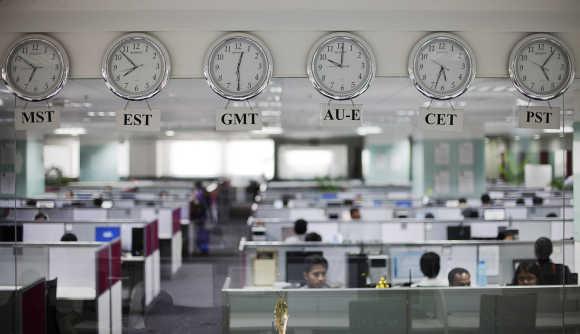 | « Back to article | Print this article |
Most in-demand jobs around the world
Despite the slow and uneven recovery from the global economic downturn and lingering high levels of unemployment in many markets, organisations around the world still report that they cannot find the talent they need when they need it, according to Manpower, a consultancy firm.
They are looking for evermore specific skill sets and taking longer to fill job vacancies as they wait for the economy to fully rebound and their businesses to get back to "normal", it says.
A study by Business Insider zeroed on twenty jobs that are most in demand.
Click NEXT to see which jobs are most in-demand across the world.
Most in-demand jobs around the world
1. Skilled Trades Workers
This year, Manpower expanded its sixth annual Talent Shortage Survey not only to gauge where employers are having difficulty filling available positions, but also examine why organisations are facing a lack of talent and what they are doing to mitigate these challenges.
Click NEXT to read more...
Most in-demand jobs around the world
The results reveal increased difficulty finding the right talent in the wake of global economic recovery with limited effort to systematically fill the gaps - and notable regional variances.
Click NEXT to read more...
Most in-demand jobs around the world
2. Engineers
ManpowerGroup research reveals employers in India, the United States, China and Germany report the most dramatic talent shortage surges compared to last year.
In India, the percentage of employers indicating difficulty filling positions jumped 51 percentage points.
Click NEXT to read more...
Most in-demand jobs around the world
Nearly one in four employers say environmental/market factors play a major role in the talent shortage - employers simply aren't finding anyone available in their markets.
Another 22 per cent of employers say their applicants lack the technical competencies or "hard" skills needed for the job, while candidates' lack of business knowledge or formal qualifications is the main reason identified by 15 per cent of employers.
Click NEXT to read more...
Most in-demand jobs around the world
3. Sales Representatives
About three-quarters of employers globally cite a lack of experience, skills or knowledge as the primary reason for the difficulty filling positions.
However, only one in five employers is concentrating on training and development to fill the gap. A mere six per cent of employers are working more closely with educational institutions to create curriculums that close knowledge gaps.
Click NEXT to read more...
Most in-demand jobs around the world
ManpowerGroup surveyed nearly 40,000 employers across 39 countries and territories during the first quarter of 2011 to gauge the impact of talent shortages on the global labour market.
The results of the sixth annual Talent Shortage Survey reveal a modest upward trend in the percentage of employers having difficulty filling positions due to lack of available talent.
Click NEXT to read more....
Most in-demand jobs around the world
4. Technicians
Globally, one in three (34 per cent) employers reports experiencing difficulties filling positions due to lack of available talent - a three percentage point rise over 2010 - while 66 per cent report no difficulties.
Click NEXT to read more...
Most in-demand jobs around the world
So while the global economic downturn may have masked the talent shortage for several years, the global recovery has made the strains of the talent shortage more evident, as organisations that cut back staff are discovering that they need more of the right people in place to move forward and support their business strategy.
Click NEXT to read more...
Most in-demand jobs around the world
5. Drivers
For the 2011 Talent Shortage Survey, employers in many countries are reporting a slight increase in difficulty, such as Japan's four percentage point increase to 80 per cent in 2011 compared to 76 per cent in 2010.
Click NEXT to read more...
Most in-demand jobs around the world
However, in some countries, including some of the largest economies in the world, employers are reporting a dramatic surge in difficulty filling positions.
Click NEXT to read more...
Most in-demand jobs around the world
6. Labourers
India and the United States report the largest increases in difficulty; in India, difficulty increased to 67 per cent in 2011 from only 16 per cent in 2010 - a 51 percentage point increase.
Click NEXT to read more...
Most in-demand jobs around the world
In the US, the difficulty increased to 52 per cent from 14 per cent, a 38 percentage point increase. These difficulties likely stem from increased demand in both countries as the economy rebounds.
Click NEXT to read more...
Most in-demand jobs around the world
7. IT Staff
When asked, "What is the one job you are having the most difficulty filling due to lack of available talent?" employers on a global basis named technicians, sales representatives and skilled trades workers to the top of the list for the fifth year in a row.
Click NEXT to read more...
Most in-demand jobs around the world
Technicians moved to the top of the list from third place last year, and skilled trades workers dropped from first on the list to third.
Engineers also remain in high demand (number four on the list), while labourers jumped to the fifth most difficult to fill position.
Click NEXT to read more...
Most in-demand jobs around the world
8. Accounting and Finance Staff
Drivers have dropped off the list and been replaced by IT staff. Compared to 2010, laborer roles, management/executives and IT roles are more difficult to fill this year, while skilled trades, accounting & finance, production operators and secretarial/administrative roles are less difficult, but still presenting challenges to employers as they seek to add these employees.
Click NEXT to read more...
Most in-demand jobs around the world
This year, for the first time, employers were asked about the impact unfilled jobs have on key constituents (customers, investors, etc.)
More than half of the employers surveyed report that when positions are not filled in a timely way there was a high (20 per cent) or medium (37 per cent) impact on key constituents, while one in four believes unfilled positions have low impact and 11 per cent say there is no impact.
Click NEXT to read more...
Most in-demand jobs around the world
9. Chefs/Cooks
The fact that 43 per cent of organisations believe the impact is low, there is no impact or they simply don't know the impact is alarming.
Manpower believes there are a few explanations for this finding.
Click NEXT to read more...
Most in-demand jobs around the world
First, employers may be delaying hiring until they see more demand. These organisations are content to leave job vacancies unfilled until their respective economies pick up.
Click NEXT to read more...
Most in-demand jobs around the world
10. Management/Executives
Second many employers believe that they can simply attract the talent they need when they need it with better pay and incentives.
This "I can buy it when I need it" approach is shortsighted, as many organisations may increase hiring simultaneously, exacerbating the talent shortage.
Click NEXT to read more...
Most in-demand jobs around the world
In either case, these companies will be in for a rude awakening when the labor market tightens and they have not developed a firm strategy for attracting and retaining the right talent.




















